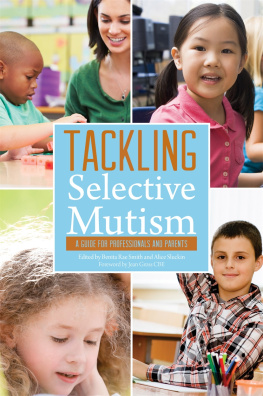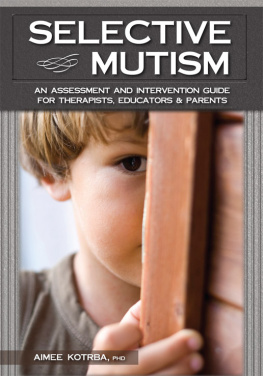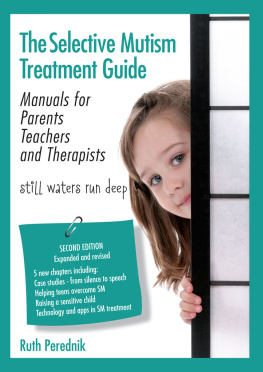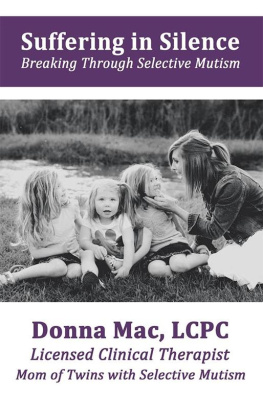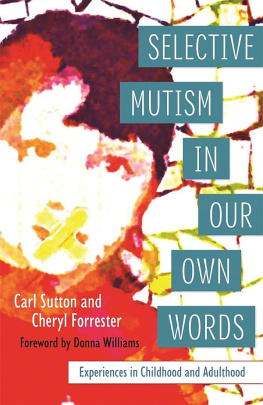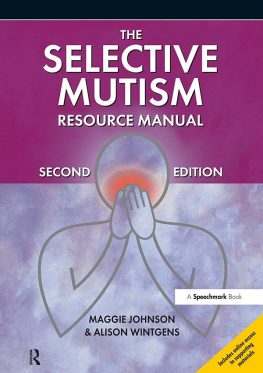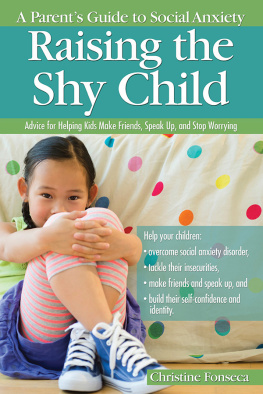Taking their school-based approach and adapting it for use by parents, the authors enlarge the audience who can benefit from their sound intervention program. The program is well-organized and employs graduated and systematic strategies that are both reasoned and researched. Building on established principles of learning, the program thoughtfully guides parents in how to teach, shape, and practice a step-by-step method for youth to overcome the fear of speaking. A welcomed addition to the literature that strives to reduce anxiety in youth, I encourage parents to read and apply the program.
Philip C. Kendall, Ph.D., ABPP, Laura H. Carnell Professor of Psychology and director of the Child and Adolescent Anxiety Disorders Clinic at Temple University
Finally, parents of children who suffer from selective mutism have a comprehensive, well-written resource to help them deal with this challenging problem. This book provides a thorough description of the disorder as well as a detailed, practical, step-by-step program for helping the child overcome selective mutism once and for all. If someone you care about suffers from selective mutism, this book is a must! It is also a great resource for teachers and for professionals who treat selective mutism.
Martin M. Antony, Ph.D., ABPP, director of the Anxiety Treatment and Research Centre at St. Josephs Healthcare and professor in the Department of Psychiatry and Behavioural Neurosciences at McMaster University, Hamilton, ON
This is, without exception, the best book for parents on the topic of selective mutism I have had the pleasure to read. Loaded with information on the nature and causes of this childhood condition and filled with practical advice on how to cope with and effectively treat it, this book provides parents with a highly useful, trustworthy, science-based program for the child with selective mutism. Few if any professionals have more clinical experience with such children and the treatment of their condition than do McHolm and Cunningham. My congratulations both to the authors for putting together such a finely crafted book and to you, the reader, for having the good sense to buy it.
Russell A. Barkley, Ph.D., research professor of psychiatry at the State University of New York Upstate Medical School in Syracuse, NY
Silence, indeed, is not always golden. Helping Your Child with Selective Mutism is a must-read for parents, educators, clinicians, and developmental researchers. McHolm and her colleagues have provided a scholarly, lucid, and practical account of how to understand and manage the child with selective mutism. The authors step-by-step program will help even the most silent child.
Louis A. Schmidt, Ph.D., associate professor of psychology and director of the Child Emotion Laboratory at McMaster University in Hamilton, ON
Finally! A well-informed perspective on an often undiagnosed, mismanaged, and misunderstood childhood anxiety disorder. The practical insights of Drs. McHolm and Cunningham and Ms. Vanier are necessary reading for parents and teachers alike. These are real strategies that can be easily incorporated into a classroom setting! Helping Your Child with Selective Mutism is a necessary addition to the bookshelves of parents and teachers everywhere!
Lin Gorenkoff, parent of a child formerly with selective mutism, and facilitator and founder of the Selectively Silent Child Support Group and Web site, www.designandcopy.ca/silentchild
The practical strategies in this bookfocusing on progress rather than failurewere instrumental in helping our child overcome selective mutism. Our sons anxiety toward speaking at school has disappeared entirely. He is now considerably more self-confident and sociable, speaking freely to his teachers and friends. I would highly recommend this approach to selective mutism to any family facing the same challenge.
Anthony Sraka, school teacher in Oakville, ON, Canada, and father of a child formerly with selective mutism

Publishers Note
This publication is designed to provide accurate and authoritative information in regard to the subject matter covered. It is sold with the understanding that the publisher is not engaged in rendering psychological, financial, legal, or other professional services. If expert assistance or counseling is needed, the services of a competent professional should be sought.
Distributed in Canada by Raincoast Books
Copyright 2005 by Angela E. McHolm, Charles E. Cunningham, and Melanie K. Vanier
New Harbinger Publications, Inc.
5674 Shattuck Avenue
Oakland, CA 94609
Cover design by Amy Shoup
Cover image: Creatas/PhotoAlto
Acquired by Tesilya Hanauer
Edited by Karen ODonnell Stein
Text design by Tracy Marie Carlson
epub ISBN: 9781608823932
Library of Congress Cataloging-in-Publication Data
McHolm, Angela E.
Helping your child with selective mutism : practical steps to overcome a fear of speaking / Angela E. McHolm, Charles E. Cunningham, and Melanie K. Vanier.
p. cm.
Includes bibliographical references.
ISBN 1-57224-416-X
1. Mutism, ElectivePopular works. I. Cunningham, Charles E. II. Vanier, Melanie K. III. Title.
RJ506.M87M34 2005
616.9284dc22
2005014370
All Rights Reserved
New Harbinger Publications Web site address: www.newharbinger.com
Contents
Foreword
Fifteen years ago when I was a novice lecturer in psychology, I supervised the clinical work of a student who had been asked to see a young child who was selectively mute. The child, lets call him Peter, was seven years old and had never spoken to anyone at school, despite the fact that his parents said that they couldnt stop him from talking at home. Like any good therapist, I told the student to search the scientific literature to find the best tested and most thoroughly supported treatments. When she returned to tell me that she could not find a single large, properly conducted study, I was shocked. We spoke to school personnel and a variety of mental health professionals and were given an incredible array of suggestions. In the end, we did the best we could, based on standard psychological principles, and Peter gradually broadened his circle of accepted confidants.
Over the past fifteen years, very little has changed. We do know a little more about selective mutism, and some descriptive research is beginning to appear. But there is still relatively little solid research into the best treatment techniques and, most frighteningly, the folklore and false information surrounding this problem are still widespread. That is one reason that this book is so important. A few months ago I was interviewed on a local television program about selective mutism. The program had filmed a young girl in grade one who did not speak to her teachers or to the other children in class. The school had been considering sending her to a special school for developmentally delayed children. I spoke on the program about the links between selective mutism and anxiety, and about how these children could be seen as similar to extremely shy children. I also talked about the fact that there was no link between selective mutism and low intelligence. After the program aired, I received many calls from parents who were angry, relieved, and grateful. They were angry because of the tremendous runaround that many of them had received from the educational and health systems. Many had been told that their child had a developmental delay such as autism, while others had been told that their child was simply being naughty or willful and loved the attention that she or he received by not speaking. Many were also told that there was nothing that could be done, that it was just a phase, and that their child would soon get sick of not speaking or grow out of it. And they were relieved and grateful because finally someone was giving them information that made sense. Parents of selectively mute children know that their child is not delayed or naughty, but they do need to know that the problem is being studied and that there do exist some good programs to help.


